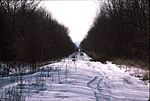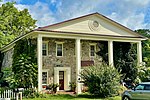Byram Township, New Jersey
1798 establishments in New JerseyByram Township, New JerseyDiscontiguous municipalities in New JerseyFaulkner Act (council–manager)Populated places established in 1798 ... and 3 more
Townships in Sussex County, New JerseyUse American English from March 2020Use mdy dates from March 2020

Byram Township is a township in Sussex County, in the U.S. state of New Jersey. As of the 2020 United States census, the township's population was 8,028, a decrease of 322 (−3.9%) from the 2010 census count of 8,350, which in turn reflected an increase of 96 (+1.2%) from the 8,254 counted in the 2000 census.The municipality is known as the "Township of Lakes", as there are roughly two dozen lakes and ponds within its borders.
Excerpt from the Wikipedia article Byram Township, New Jersey (License: CC BY-SA 3.0, Authors, Images).Byram Township, New Jersey
Iron Mine Road, Byram Township
Geographical coordinates (GPS) Address Nearby Places Show on map
Geographical coordinates (GPS)
| Latitude | Longitude |
|---|---|
| N 40.960286 ° | E -74.713332 ° |
Address
Iron Mine Road
Iron Mine Road
07821 Byram Township
New Jersey, United States
Open on Google Maps





